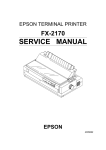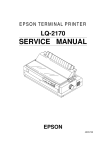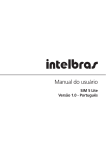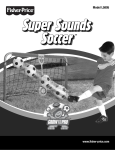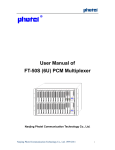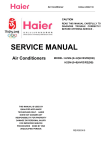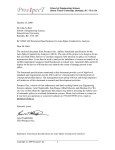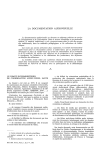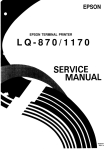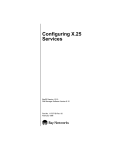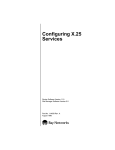Download AIRAT2 USER MANUAL
Transcript
AIRAT2 USER MANUAL Contents AIRAT2 1. Specifications 2. Introduction 3. Features 4. Battery 1) Connection 2) Charge MOUSE OPERATION 1. Introduction 2. Downloading Program 3. Mouse Operation and Main Menu 1) Key Operation 2) Main Menu 4. RUN Test 5. Program Explanation 1) Simulator Program 2) AIRAT2 Program 3) Miscellaneous Program 6. Driving Stepping Motor Main Board Silkscreen Main Board Schematic Sensor Board Schematic AIRAT2 1. Specifications Item Description SIZE 114 × 88 mm CPU BOARD BODY FRAME JS8051-A2 with LCD WHEEL Aluminum Wheel(ø51.3 with rubber) × 2, small-size 144 × 67 mm(Aluminum) Ball Caster × 2 MOTOR Stepping Motor(H546) × 2 SENSOR IR LED(EL-1KL) × 6, Photo TR(ST-1KL) × 6 BUZZER LED Piezo Buzzer(BTG-47) driving by frequency 1 Power LED, 3 User-LED. KEY Reset, User Key × 2. SERIAL RS232C(115,200 bps down loading). BATTERY Packed NiMH(7.2 Volt 450 mAh) × 2 POWER DC 14.4V OTHER .User program can be downloaded to RAM or FLASH memory with default 115,200 bps. .FLASH memory works like EEPROM. .Serial Cable. .Sample Program(C Language). .Serial Downloading Program & Utilities. .Software Mouse Simulator & Source(Borland C++) 2. Introduction AIRAT2 is a micromouse robot which uses an 8051 CPU. The AIRAT2 emits a beam of infrared light and uses sensors to receive the amount reflected back. The CPU board utilizes the JS8051-A2 board. The JS8051-A2 is very well constructed. It uses powerful outside resources such as LCD, ADC, two external Timers, Self FLASH Writing and more, thus allowing the hardware to be easily and conveniently developed. The AIRAT2 has 6 sensors enabling it to move diagonally. A PC simulator is provided which enables the user to more easily understand the high-level mouse search algorithm. The C source code is provided so that the programmer can easily develop algorithms, which can be tested on the simulator and then moved to the mouse. In addition, LCD, serial communication, mouse control and other functions are provided as library and source files. Besides the basic utility program, the programs generating accelerating/decelerating table code and various turning table codes are provided with their sources. For those who want to learn high-level mouse skills AIRAT2 provides an excellent environment for development, test environments, algorithms and much more. 3. Features • Uses the convenient JS8051-A2 development environment.(refer to JS8051-A2 manual). • Ability to constantly self adjust and move diagonally using 6 sensors. • Sleek design, small size and easily assembled/disassembled. • PC simulators used to accelerate development and testing. • During development information encoded on the mouse can be viewed using a PC. • Libraries, source codes and utilities are provided. • Convenient recharging port (no need for the batteries to be taken out). • Produces a variety of sounds through frequency control. • Arrangement of LED with design in mind and clean cable disposition. • Assembly instructions and user's manual. 4. Battery 1) Connection The AIRAT2 uses two 7.2V NiMH(450mA) packed batteries. One is at the front, and the other is at the back of the robot. Connect the front battery to the JP3 and the rear battery to the JP4, which are underneath the AIRAT2’s main board. The batteries might not be fully charged upon purchase. 2) Charge A power supply is required to charge the batteries, which have a current limitation function. The two batteries should be connected to the robot (main board) before charging. (1) Set the power supply voltage to 17V and max current to 200 mA . At this setting, the power supply provides 17V up to 200 mA of current output. This is called CV (Constant Voltage) mode. The power supply provides a constant 200 mA even if the outside circuit requires more than 200 mA. This is called CC (Constant Current) mode. Generally, a power supply has LED’s to indicate the CV and the CC mode. (2) Connect the provided charging cable to the JP9 port on the main board. (3) Connect the charging cables (RED(+), BLACK(-)) to the power supply(17V, 200mA current limit). Pay attention to the polarities. (4) The charging time depends on the battery’s state and the charging current. In the case of totally discharged battery, it will take approximately 3 hours with 200mA charging current. (5) Over charging produces heat. Check the batteries regularly. When the batteries are warm, stop charging. MOUSE OPERATION 1. Introduction A mouse is a robot which finds its way through a 16 × 16 block maze(Please refer to mouse_rule(e).htm on the enclosed CD.). The mouse begins by acquiring information about the walls. The first time the mouse goes through the maze it does so without knowing anything about the maze. After it reaches the goal of the maze, it returns to the beginning and runs through the maze a second time. On the second run-through the mouse uses information it "learned" on its first trip. This time it make no wrong turns and travel faster. It again returns to the beginning and repeats the process, going quicker each time. AIRAT2 is a magnitude of reflected light type of robot. It projects a beam of infrared light at a wall and judges distances by the amount of light reflected back. It creates and uses its own table of A/D converted values of the amount of light vs. distance to a wall. The magnitude of reflected light vs. distance table varies slightly depending upon the infrared emitter, sensor, ambient light, wall status, etc. It would be more exact to create the table beforehand, but this is not necessary. 2. Downloading Program In order to test the mouse you must transfer the provided AI2_DEMO.BIN program to the flash memory of the JS8051-A2 CPU board. To do this it is necessary to read the JS8051-A2 CPU board manual first. Transmit AI2_DEMO.BIN following the steps below. Connect the serial cable PC with the JS8051-A2 CPU board. Go to DOS mode in the PC. Go to the AIRAT2 folder. After that, type the following. UPA2H AI2_DEMO.BIN ↵ (↵ : Press Enter) The PC is now ready for transmission. If the JP6's jumper block is pressed in on the JS8051-A2 CPU board pull it out. Turn on the power when the AIRAT2's S3(blue) key is pressed. Then remove your finger from the S3 key. When the S2(green) key is pressed serial downloading begins. Then the transmitting byte is shown on the PC monitor. When transmission is complete, press the jumper block of JP6, press reset button or turn it off on the JS8051-A2 CPU board. After the beep sounds, the LCD will work. This means the mouse is working properly. If it makes a low sound remove the buzzer's waterproof tape. Turn the potentiometer R4 on the JS805-A2 board counterclockwise as far as it will go. Then, position the potentiometer VR1 on the bottom left side of the AIRAT2 main board to one o'clock. This potentiometer is able to set up electric current to the motor. If the current is set too low the motor will have no power. However, if it is set too high, it will just eat up power and cause the mouse's wheels to slide when starting. Figure 2-1 Potentiometer for reference voltage of ADC on the JS8051-A2 board. Set the dial to the 1 o'clock position Figure 2-2 Setting the potentiometer of AIRAT2. 3. Mouse Operation and Main Menu 1) Key Operation The three keys S1(red), S2(green), S3(blue) on the AIRAT2 main board have the same function as S1, S2, S3 keys on the JS8051-A2 board. Thus it is convenient to use the big push switch on AIRAT2 when downloading. The mouse starts operating with a beeping sound after downloading the flash memory. Don't forget to push JP6's jumper block and restart after downloading. After the mouse starts, the role of the S2, S3 key is determined by the mouse program. In the demo program provided the functions are: S2 : Change menu key(also the cancel key) S3 : Enter key After the mouse is turned on, the LCD displays the operation menu. You can change the menu by pressing the S2 key. To operate the chosen(appearing) function press the S3 key. When there are more sub menus to choose, press selection(S2) key and then performing(S3) key. If after performing the sub-menu you want to choose a main menu, press the reset key and start again from the beginning. Don't worry about the previously chosen menus, they will be maintained. However, be aware that all information in the memory will be erased if the power is switched off. 2) Main Menu First Go : First run. While investigating the maze the mouse stores information about the wall and determines the center goal. When the first run starts the existing wall information is completely erased and it receives new wall info. When the S3 key is pressed the message "Motor on Run now?" appears. This means "The power is supplied to the motor and shall I operate?". If you want to start press the S3 key. Second Go : It determines the middle goal with the stored wall information. Level 0 : It goes to and from the goal by making rectangular turns. Level 1 : It goes to and from the goal by making smooth turns. Level 2 : The speed increases slightly from 'level 1' and make smooth turns. Level 3 : The speed increases slightly from 'level 2' and make smooth turns. Level 4 : The speed increases slightly from 'level 3' and make smooth turns. Front Table : To create the two front wall sensor tables. When you press the S3 key the message "Load default?" comes up. This prompt is asking whether you're going to use the table values already in the mouse. This value is the result of previously entered sample values that were written to ROM. Therefore, there could be a difference between the ROM's data and the sampling data of the maze if you change the maze environment or the sensors. In this case it is a good idea to press S2(cancel) key and begin making a new table. If instead of pressing S2 key you press S3, the table in the ROM is used as the sensor table. If you want to create a new table of distance vs. magnitude of reflected light press S2. Then a message will flash "Motor On Run now?". Now place the mouse against the front wall of the maze. Be sure that there is no room between the mouse and the front wall. Next press the S3(enter) key. Remember to give the mouse approximately 25 cm(=9.84 in = 0.82 ft) of space to move backwards. An empty space of three blocks should be appropriate. The mouse moves backward then forward slowly making the two front tables. 1 2 Figure 3-1 Generating front sensor table data. Side Table : To create the four side wall sensor tables. A message "Motor On Run now?" will flash upon pressing the S3 key. Place the mouse in the center of an area enclosed by left and right walls and press the S3 key to operate. Then the mouse will move left and right creating the tables. Next, a message "right most plz" will flash. Place the mouse very close to the right wall and press the S3(enter) key. After a "beep" a message "left most plz" will flash. Place the mouse very close to the left wall and press the S3(enter) key. The table is created when the "beep" sounds. 2 1 3 6 Figure 3-2 Generating side sensor table data. 4 5 Sensor Test : Testing the selected sensor. Select the sensor you want to operate by pressing the S2 key. This will be indicated on the LCD by the display value of the selected sensor. In a case where two sensors have been selected, the upper line will be the read value and the bottom line will be the appropriate distance according to its value. If the four sensors are selected, only the distance to the wall will be displayed. If you want to test other sensors press the S3(enter) key and then the S2(select) key to select again. "LF RF" : Left Front & Right Front. "L45 R45" : Left 45°& Right 45°. "L R" : Left & Right. "L45 R45/L R" : Left 45°Right 45°,Left & Right. Table Transfer : To transfer the table of distance vs. magnitude of reflected light to the PC with serial communication. While in operation a message "Which Table?" will flash, then a message "L_Front Table" will flash. Press the S2(select) key to select the sensor you want to transmit and then press the S3(enter) key to transmit the table values. When you want to continue transmitting other sensor tables use the S2 key to select again. In order to confirm the transmitted value on the PC use the SERIAL57.EXE(util folder) or hyper terminal(utility of Windows) or other serial communication program. The transmission format is 57,600 bps N81(No parity, 8 bit data, 1 stop bit). Use the hyper terminal to capture the value and use the correct DEFLT_T.INC(default table array file). You can then make and insert a table suitable to your maze in the program. Of course, you must compile to do that. Left_45 Left L_Front Right_45 Right R_Front Figure 3-3 Sensor placement. Get Sample : While operating at 240 pulses it memorizes the distance value of all the sensors. After acquiring the value it automatically goes into serial transmission mode. Here you have three selections "L R", "L45 R45", "LF RF". Use the S2 key to select one and use the S3 key to transmit the value. In order to transmit the second data block press the S3 key once more. After the transmission is complete use the S2 key to transmit the reflected light table of the other sensors. Mem Transfer : Transmit the value of the byte array mem[256]. The mem[256] is a defined global variable in the program. This value does not become erased even if the reset key is pressed. The mem array is for debugging. While the mouse is moving you can confirm the value by saving the value you want to know in the mem[256] and then enter into this menu and serial transmit through the PC. Real-time monitoring is difficult for the mouse. This is because it uses independent power to move about. (I have looked into using the RF module for wireless transmission but there was no time to serial transmit during a fast run. Even if the system was faster the serial interruption would have had considerable effect on the mouse program. Therefore, as a counterproposal I have thought of this. Try it! You'll find that it's very convenient with no burden on the main program.) User Test: This was devised to allow the user to test any special (mathematical) functions we have entered for default. For example; "LT 0" : Left turn "RT 1" : Left turn(static turn) "UT 2" : U-turn "Go 400p 3" : Go 400 pulses. "Go Block 4" : Go 1 Block. The mouse goes forward one block(180mm). If it doesn't reach 180mm the wheels will spin and/or skid. In this case the skidding and/or spinning state must be reduced as much as possible by adjusting the AIRAT2 potentiometer(VR1). "Level 5" : empty "Level 6" : empty The empty spaces can be filled and used as a option by the user. 9 No OP : No OPeration. No 9 main menu is empty. First Go Second Go Level 0 Level 1 Level 2 Level 3 Level 4 Front Table "Load default?" S3 S2 Side Table make table 1,2,3,4 Load default table newly make table "right most plz" make table 5 Sensor Test Table Transfer Get Sample LF RF L45 R45 L R L45 R45/L "left most plz" R L_Front Table Left Table Left_45 Table Right_45 Table Right Table R_Front Table L R L45 R45 LF RF Mem Transfer User Test 9 No OP LT RT UT Go 400p Go Block Level Level 0 1 2 3 4 5 6 make table 6 Figure 3-4. Main menu. 4. RUN Test To run the mouse a maze is needed. A 16 × 16 full maze is ideal but a 9 × 9 maze will suffice. Because the targets ((7,7) (7,8) (8,7) (8,8)) are in the maze you can test the second run. However, if a 9 × 9 maze is unavailable, a 5 × 5 maze must be used. If in the 5 × 5 maze the mouse cannot find the goal, it realizes there are no other paths to follow and will stop. It is possible to program the mouse to search for the goal at position (4,4) but this is too small a sample area to do many tests. If one has a proper maze with a suitably positioned goal test the mouse as explained below. Ensure that the motor current limit potentiometer is set properly and that the battery is charged. 1) Create the front table. Front Table Menu(S3) ⇒ "Load Default?"(S2) ⇒ "Motor on run now?"(S3) 2) Create side table. Side Table Menu(S3) ⇒ "Motor On Run Now?(S3) ⇒ "right most plz"(Place it along the right wall S3) ⇒ "left most plz"(Place it along the left wall S3) 3) First Run. Fist Go(S3) ⇒ "Motor On Run Now?"(S3) 4) If a second run test is required. Second Go(3) ⇒ level 0~4 ⇒ "Motor On Run Now?"(S3) 5. Program Explanation 1) Simulator Program AI_SIM5.EXE is the mouse simulation program. If you run the program the menu below will appear. 1. Load maze: Reading the maze 2. Run : Run 3. Step run : Not running now 4. Edit maze : Maze editor 5. Save maze 6. Clean trace : To erase trace 7. Clean maze : Erase the maze completely. 8. Quit Press the arrow key or key in the numbers or use the space bar and press the enter key to start operating. On the bottom right hand side of the screen the applicable operation menu will appear. If you wish to quit during the run you must press the Esc key several times. You can make this simulation program by compiling the provided source file with Borland C++(BC.EXE) compiler. The file provided is as such. AI_SIM5.PRJ : Project File AI_SIM5.CPP : Main Project Source. AI_GRAPH1.CPP : Functions about graphics. AI1.H : Header file *.MAZ : Maze file AI_SIM5.CPP and AI_GRAPH1.CPP are bound to the AI_SIM5.PRJ project file. The source is all in C language. The algorithm or functions used in the simulator are almost all used in the real mouse program. Therefore, it's a good idea to learn and test the algorithms in the simulator before starting to learn the real mouse program. To explain the whole program would be too much. It would probably turn out to be quite a thick book. This is an outline to explain the functions. initialize_data() Set up information about maze walls beforehand. According to convention the maze perimeter must be 16 × 16 and enclosed. Three walls are closed at the starting point. The mouse's starting point coordinates are (0,0) and it is directed north. make_real_map(x1, y1, x2, y2, dir) Create a path by what it knows from points (x1, y1) to (x2, y2). Set count, direction, array value. Assume that unknown routes are blocked. make_virtual_map(x1, y1, x2, y2, dir) Create an imaginary path from point(x1, y1) to (x2, y2). Assume that unknown routes are open. make_virtual_goal_map(x1,y1,dir) Create an imaginary route from point (x1, y1) to the closest goal. Assume that unknown routes are open. make_all_virtual_map(x1, y1,dir) Create an imaginary route from point (x1,y1) to all the blocks in the maze. Assume that unknown routes are open. trace_virtual_path(x,y) Fill up to 0 from point (x1,y1) to the current mouse position. If there are routes that it hasn't explored, it saves those positions on vrstack. Accordingly, the upper most position on the stack is the closest two-way path from where the mouse is currently positioned. trace_virtual_path2(x,y) This is the same as trace_virtual_path function but the graphic route is excluded. trace_virtual_path3(x,y) This is the same as trace_virtual_path functions but the operations of saving stack is excluded. trace_real_abs_path() Fill up to 0 from point(0,0) to the current position of the mouse. trace_vir_abs_path() Create an imaginary route from point(0,0) to (goal_x, goal_y). make_run_table(x1, y1, x2, y2, dir) Create a run_table[] from point (x1,y1) to (x2,y2). In the run_table[] there are sequences that the mouse must take. For example, "left turn, forward, forward, right turn, forward,...stop" mark_count_array_with_zero(x,y) Fill the path(count array) up to 0 from point(x,y) to the current position of the mouse. set_nearest_vrstack_position() Place the position on the vrstack that would be the closest to the current position on the upper most of the vrstack. In other words, sort by distance. fastrun() Run according to the run_table[] contents. turn2dir(dir,turn) When the mouse is going in the dir direction, turn it in the turn direction, then return to the direction the mouse would get. search_go al() initialize_data() make_virtual_goal_map(mouse_x, mouse_y, cur_dir) go_vir_stack_position() Memorize after reading wall information NO go al_in(): Is the go al in ? YES Return Figure 5-1 Flow chart of first go. find _m ore _s ho rt_ pa th() YES real m ap co unt[0][0 ] == v irtu al m ap c oun t[0][0 ] NO make_virtual_map(goal_x,goal_y,0,0,goal_dir) set_nearest_vrstack_position() make_virtual_map(mouse_x,mouse_y,vrstack[].x,vrstack[].y,cur_dir) go_vir_stack_position() Memorize after reading wall information Figure 5-2 Flow chart of second search. 2) AIRAT2 Program The program given for operating AIRAT2 is given as such. AI2_DEMO.C : Main program AI_BASE.H : Definition about mouse hardware and basic functions. AI_SIM1.H : The header file used in the simulator. Used in AI2_DEMO.C, too. A2_SERIAL.H : Serial library definition. A2_LCD.H : LCD library definition. A2_DELAY.H : Delay library definition. A2SERIAL.R03 : Serial library A2LCD.R03 : LCD library A2DELAY.R03 : Delay library AI_BASE.R03 : Library of basic function of the mouse. GO_TABLE.INC : Acceleration table 90_TABLE.INC : 90° turn (rectangular turn) table. 180TABLE.INC : 180° turn table. R e turn SMOOTH.INC : 90° turn(smooth turn) table. DEFLT_T.INC : Default table of distance vs. reflected light. JS51A2M.XCL : Linker control file of JS8051-A2 board. X.BAT : A batch file summing up compile, link, bin conversion, downloading and more. SET_IAR.BAT : A batch file the author uses for creating IAR environment. Must use after adjusting according to your environment. A2_DEMO.BIN : Executable file of A2_DEMO.C. You can use this by downloading on JS8051-A2 board directly. The central algorithm of AI2_DEMO.C program is almost the same as the simulator program. Functions for controlling the hardware directly have been supplemented and the functions relating to graphics were removed since they were not needed. To understand the mouse program immediately is too difficult. You must understand the simulator source before you start studying this program. The main variables and functions are as follows. left_trim_flag : when the mouse is inclined towards the left it is set to 1. In this case run the left motor quickly to arrange. right_trim_flag : when the mouse is inclined towards the right it is on 1. In this case run the right motor quickly to arrange. large_trim_flag : when the mouse is inclined much to one side of the wall it is on 1. In this case arranging intensity gets bigger. dist_bojeong_flag : when the mouse is running if the wall next to it or the pole disappears it adjusts it's distances from where it is. return_from_multi_go : This shows whether in fastrun() it returned after more than two actions(turn, forward). when this value is 1 it is so that the mouse coordinates would not have to be modified. end_operation : If the left motor(left_end_op) and right motor(right_end_op)'s operation is all completed the appropriate bit would each become 1 and their byte became 00000011b. pre_sturn_flag : If the action right before was a smooth turn it is on 1. This to take care of continuous smooth turns separately. 1_index, r_index : The index for left, right motor straight line acceleration table. sl_index, sr_index : The index for left, right motor turn acceleration table. 1, r, 145, r45, If, rf : The distance to the wall that the individual left side, right side, left side 45°, right side 45°, left side ahead, right side ahead sensor shows. l_history, r_history, l45_history, r45_history, lf_history, rf_history : It has the history of the wall information it received from its six sensors. The LSB shows current(or the latest) wall presence and the MSB shows the previous seventh wall. If the value is 11111110b it could be said that the wall was there in the past and started to disappear recently. However you must take into consideration that the wall information could not be correct because of the noise. gone : It shows the distance in steps the mouse has gone. However, at every middle block it resets to 0. Therefore, it does not have step values of more than one block. l_wall, r_wall, 145_wall, r45_wall, f_wall : It shows the information whether or not there is a wall currently in the direction it is going in. pre_l_wall, pre_r_wall : It shows whether there has been a wall in the past(the sampling immediately before). If the operator is using the existence of the current wall together with the sampling taken immediately before, it can predict at what point the walls will disappear or appear. pulse_go( WORD pulse_count ) Output pulse_count to the motor. static_mm_go( BYTE mm ) It goes at the distance of mm. The distance variable unit is mm(millimeter). One must be cautious that the parameter mm is the byte variable. static_degree_turn( BYTE angle ) Turn as much as the angle. change_run_table(void) Change the multiple one-block forward movements into one long forward movement. change_run_table2(void) Change the right-angle turn into a smooth turn set_count_l( WORD v ) The function for setting up the v value of the outer timer0(inside M4-64/32) that controls the left motor. This value shows when the next interrupt will come(it's a time constant). The bigger the value the longer intervals between interrupt and the motor will turn more slowly. It is not just writing the v to the timer0. It changes the proportion of v according to the trim_flag. set_count_r( WORD v ) set_count_r() has the same ability as set_count_1 but applicable to the right motor. EX0_int (void) This is interrupt 0's ISR(Interrupt service routine) and it manages the left motor. At the end of the function, TF0(8051 inside timer interrupt 0 flag) is set to 1, this is in order to make a sensor interrupt(timer interrupt 0). You can see the sensor interrupt is executed every two interrupt 0. Because of the CPU speed a slight expedient was used. EX1_int (void) This is interrupt 1's ISR(Interrupt service routine) and it manages the right motor. T0_int (void) The function of adjustment that is considered the most difficult. It is forcefully called from EX0_int(). This happens here for position adjustment and others such as distance adjustment. T1_int (void) It periodically reads the sensors. Whenever an interrupt happens it only reads the two sensors and renews. 3) Miscellaneous Program In the utility folder there are some acceleration table and sources to generate them. If you use Borland C 3.1 you can compile. You can get the table when you use redirection(>). Example) A2_TABLE > GO_TABLE.INC 40 80 88 Unit: mm Figure 5-3 Outlines of AIRAT2 6. Driving Stepping Motor AIRAT2 utilizes two PLDs(Programmable Logic Device) to generate control signals for the two stepper/stepping motors. Each PLD(16V8) controls each motor. The PLD(16V8) can generate a two-phase-on full step (2-phase) signal and a half step (1-2-phase) signal. AIRAT2 uses half step signal to drive stepper motor. Two SLA7204Ms, unipolar stepper motor controller/driver, are used as stepper motor drivers. Refer to the pdf data in the CD for more details. The provided two 16V8 chips are already programmed. The PALASM source and *.jed file of the PLD are provided in the CD. Signal Function CLK_L(R) Clock for the motor. The speed of the clock is the speed of the motor DIR_L(R) Direction of the motor. 0=counterclockwise, 1=clockwise EN_L(R) Motor enable. 0=enable(Turn on), 1=disable(Turn off) PHASE Driving method select. 0 = ‘2-phase’, 1 = ‘1-2-phase’ Table 6-1 Signals for 16V8 PLD A stepper motor steps by switching the windings in sequence. The following two modes are available for the AIRAT2. AIRAT2 uses a half step mode as default. 1 : energize. 0 : de-energize. 1 2 3 4 A 1 0 0 1 B 1 1 0 0 /A 0 1 1 0 /B 0 0 1 1 Table 6-2 Two-phase-on full step mode (2-phase) 1 2 3 4 5 6 A 1 0 0 0 0 0 B 1 1 1 0 0 0 A 0 0 1 1 1 0 /B 0 0 0 0 1 1 Table 6-3 Half step mode (1-2-phase) 7 1 0 0 1 8 1 0 0 0 The ‘PHASE’ signal outputs are pulled-up(refer to schematic) to the VCC and the JS8051-A2 doesn't control it. Therefore, AIRAT2 is made to move according to default ‘1-2-phase’ (half step) driving method. If you want to change to the ‘2-phase’ driving method, short the SMD jumper JP8. If changed to the ‘2-phase’, the motor interrupt will decrease and the mouse will speed up but it will spin and/or skid and will lose its reliability and become unstable. It is understood that to use the ‘2phase’ driving method all aspects of the program must be correct. It appears that the ‘1-2-phase’ driving method is more advantageous than ‘2-phase’ method for this mouse. www.microrobot.com Main Board Silkscreen 8 7 6 5 4 3 2 1 MVCC U1 CLK_L DIR_L EN_MOT RP5 10K 1 2 3 4 5 6 7 8 9 11 5 4 3 2 D PHASE U2 I0 I1 I2 I3 I4 I5 I6 I7 I8 I9 F0 F1 F2 F3 F4 F5 F6 F7 INA1 INA2 INA3 INA4 12 13 14 15 16 17 18 19 CLK_R DIR_R EN_MOT 1 2 3 4 5 6 7 8 9 11 PHASE 2 1 VCC JP8 SMD JUMPER2 F0 F1 F2 F3 F4 F5 F6 F7 INB1 INB2 INB3 INB4 12 13 14 15 16 17 18 19 VCC C1 16V8 1 2 3 4 5 9 RSA 3 REFA 14 REFB 10 RSB C2 100 2200pF OUTA OUTA OUTB OUTB 1 8 11 18 TDA TDB GA GB 2 13 4 15 JP1 RP3 C5 SLA7024M R5 R6 1 1 P1.3 S3 PUSH SW HEADER 6 VCC 1 C6 470pF MVCC 2 3 4 5 S2 PUSH SW L_MOTOR 47K 470pF RP4 1K S1 PUSH SW D 1 2 3 4 5 6 2 3 4 5 1 2.2K VSA VSB 7 12 INA INA INB INB 2200pF RP2 VR1 P1.2 6 5 17 16 R2 510 VCC VCC C9 220uF 25V U3 INA1 INA2 INA3 INA4 1 16V8 + I0 I1 I2 I3 I4 I5 I6 I7 I8 I9 + C10 220uF 25V U4 RESET D2 LED D3 LED LEFT_LED C INB1 INB2 INB3 INB4 D4 LED RIGHT_LED 6 5 17 16 FRONT_LED C3 D0 D1 D2 D3 D4 D5 WRCS1 11 1 D1 D2 D3 D4 D5 D6 D7 D8 Q1 Q2 Q3 Q4 Q5 Q6 Q7 Q8 19 18 17 16 15 14 13 12 VCC U6 9 RSA 3 REFA 14 1 2 3 4 5 6 7 8 BUZZER CLK OC IN0 IN1 IN2 IN3 IN4 IN5 IN6 GND IR1 IR2 IR3 IR4 IR5 IR6 16 15 14 13 12 11 10 9 Q0 Q1 Q2 Q3 Q4 Q5 Q6 COM REFB 10 RSB C4 2200pF SP1 PIEZO OUTA OUTA OUTB OUTB 1 8 11 18 TDA TDB GA GB 2 13 4 15 INA INA INB INB 2200pF U5 2 3 4 5 6 7 8 9 VSA VSB 7 12 SLA7024M R7 R8 1 1 JP2 1 2 3 4 5 6 C R_MOTOR HEADER 6 C7 C8 470pF 470pF TD62003 74HC574 C17 T3 AIN1 103 C18 VCC TEST T4 AIN2 JP5 B 1 3 5 7 9 11 13 15 17 19 21 23 25 27 29 31 33 DIR_L LEFT_LED P1.2 BUZZER D5 D3 D1 VCC JP6 2 4 6 8 10 12 14 16 18 20 22 24 26 28 30 32 34 DIR_R P1.3 EN_MOT RIGHT_LED AIN1 AIN3 AIN5 T6 TEST D4 D2 D0 WRCS1 CLK_L PULSE0 VCC 16 14 12 10 8 6 4 2 JP7 15 13 11 9 7 5 3 1 AIN2 AIN4 AIN6 VCC PULSE1 TR_IN1 TR_IN2 TR_IN3 TR_IN4 TR_IN5 TR_IN6 14 12 10 8 6 4 2 CLK_R RP1 IR1 IR2 IR3 IR4 IR5 IR6 13 11 9 7 5 3 1 1 2 3 4 5 6 7 8 9 103 C19 TR_IN1 TR_IN2 TR_IN3 TR_IN4 TR_IN5 TR_IN6 + C14 220uF/10V AIN4 103 C21 AIN5 4.7K 103 C22 FRONT_LED RESET 103 S4 2 1 HEADER 2 C15 100uF/25V 4 OUT 2 2 3 4 5 6 7 1 10K L1 330uH ON 2 1 JP3 GND HEADER 2 + 3 A SW JP9 AIN1 AIN2 AIN3 AIN4 AIN5 AIN6 VCC FBACK VIN 5 1 2 1 TEST RP6 U7 LM2575 MVCC T5 AIN6 HEADER 17X2 JP4 B 103 C20 HEADER 7X2 HEADER 8X2 TEST AIN3 + D5 1N5819 C16 220uF R1 1K D1 LED C11 0.1uF C12 0.1uF C13 0.1uF T1 TEST A T2 TEST Microrobot Co.,Ltd HEADER 2 Title AIRAT2 8 7 6 5 4 3 Size B Document Number Date: Saturday, July 01, 2000 2 Rev n Sheet 1 of 1 1 8 7 6 5 4 3 2 1 D D VCC R1 3.3 ohm Q1 ST-1KL D1 JP1 TR_IN1 TR_IN2 TR_IN3 TR_IN4 TR_IN5 TR_IN6 VCC 14 12 10 8 6 4 2 13 11 9 7 5 3 1 EL-1KL D3 IR1 IR2 IR3 IR4 IR5 IR6 L_Front TR_IN2 Left TR_IN3 Left_45 TR_IN4 Right_45 TR_IN5 Right TR_IN6 R_Front Q2 ST-1KL EL-1KL D2 C TR_IN1 C Q3 ST-1KL EL-1KL D4 Q4 ST-1KL EL-1KL D5 HEADER 7X2 Q5 ST-1KL EL-1KL D6 Q6 ST-1KL EL-1KL YELLOW BLACK B B A A Microrobot Co., Ltd Title AIRAT2_SENSOR 8 7 6 5 4 3 Size B Document Number Date: Saturday, July 01, 2000 2 Rev n Sheet 1 of 1 1

























